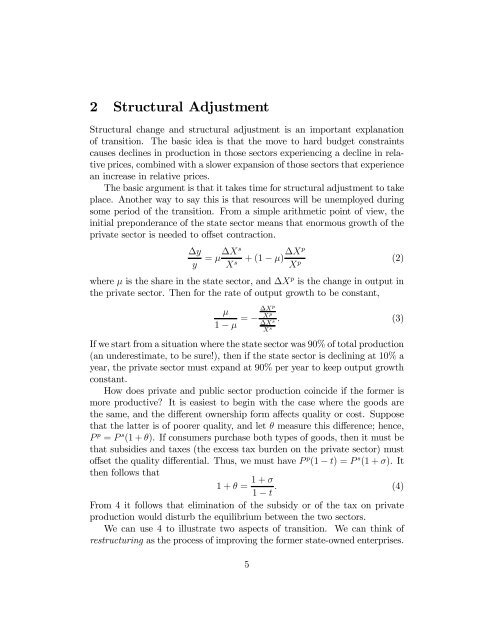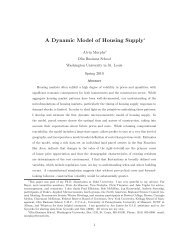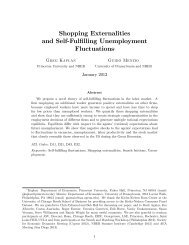Note on Adjustment and the Specific Factor Model
Note on Adjustment and the Specific Factor Model
Note on Adjustment and the Specific Factor Model
Create successful ePaper yourself
Turn your PDF publications into a flip-book with our unique Google optimized e-Paper software.
2 Structural <strong>Adjustment</strong>Structural change <strong>and</strong> structural adjustment is an important explanati<strong>on</strong>of transiti<strong>on</strong>. The basic idea is that <strong>the</strong> move to hard budget c<strong>on</strong>straintscauses declines in producti<strong>on</strong> in those sectors experiencing a decline in relativeprices, combined with a slower expansi<strong>on</strong> of those sectors that experiencean increase in relative prices.The basic argument is that it takes time for structural adjustment to takeplace. Ano<strong>the</strong>r way to say this is that resources will be unemployed duringsome period of <strong>the</strong> transiti<strong>on</strong>. From a simple arithmetic point of view, <strong>the</strong>initial prep<strong>on</strong>derance of <strong>the</strong> state sector means that enormous growth of <strong>the</strong>private sector is needed to offset c<strong>on</strong>tracti<strong>on</strong>.∆yy= µ∆Xs X s+(1 − µ) ∆XpX p (2)where µ is <strong>the</strong> share in <strong>the</strong> state sector, <strong>and</strong> ∆X p is <strong>the</strong> change in output in<strong>the</strong> private sector. Then for <strong>the</strong> rate of output growth to be c<strong>on</strong>stant,∆Xµp1 − µ = − X p. (3)∆X sX sIf we start from a situati<strong>on</strong> where <strong>the</strong> state sector was 90% of total producti<strong>on</strong>(an underestimate, to be sure!), <strong>the</strong>n if <strong>the</strong> state sector is declining at 10% ayear, <strong>the</strong> private sector must exp<strong>and</strong> at 90% per year to keep output growthc<strong>on</strong>stant.How does private <strong>and</strong> public sector producti<strong>on</strong> coincide if <strong>the</strong> former ismore productive? It is easiest to begin with <strong>the</strong> case where <strong>the</strong> goods are<strong>the</strong> same, <strong>and</strong> <strong>the</strong> different ownership form affects quality or cost. Supposethat <strong>the</strong> latter is of poorer quality, <strong>and</strong> let θ measure this difference; hence,P p = P s (1 + θ). If c<strong>on</strong>sumers purchase both types of goods, <strong>the</strong>n it must bethat subsidies <strong>and</strong> taxes (<strong>the</strong> excess tax burden <strong>on</strong> <strong>the</strong> private sector) mustoffset <strong>the</strong> quality differential. Thus, we must have P p (1 − t) =P s (1 + σ). It<strong>the</strong>n follows that1 + θ = 1 + σ1 − t . (4)From 4 it follows that eliminati<strong>on</strong> of <strong>the</strong> subsidy or of <strong>the</strong> tax <strong>on</strong> privateproducti<strong>on</strong> would disturb <strong>the</strong> equilibrium between <strong>the</strong> two sectors.We can use 4 to illustrate two aspects of transiti<strong>on</strong>. We can think ofrestructuring as <strong>the</strong> process of improving <strong>the</strong> former state-owned enterprises.5
















